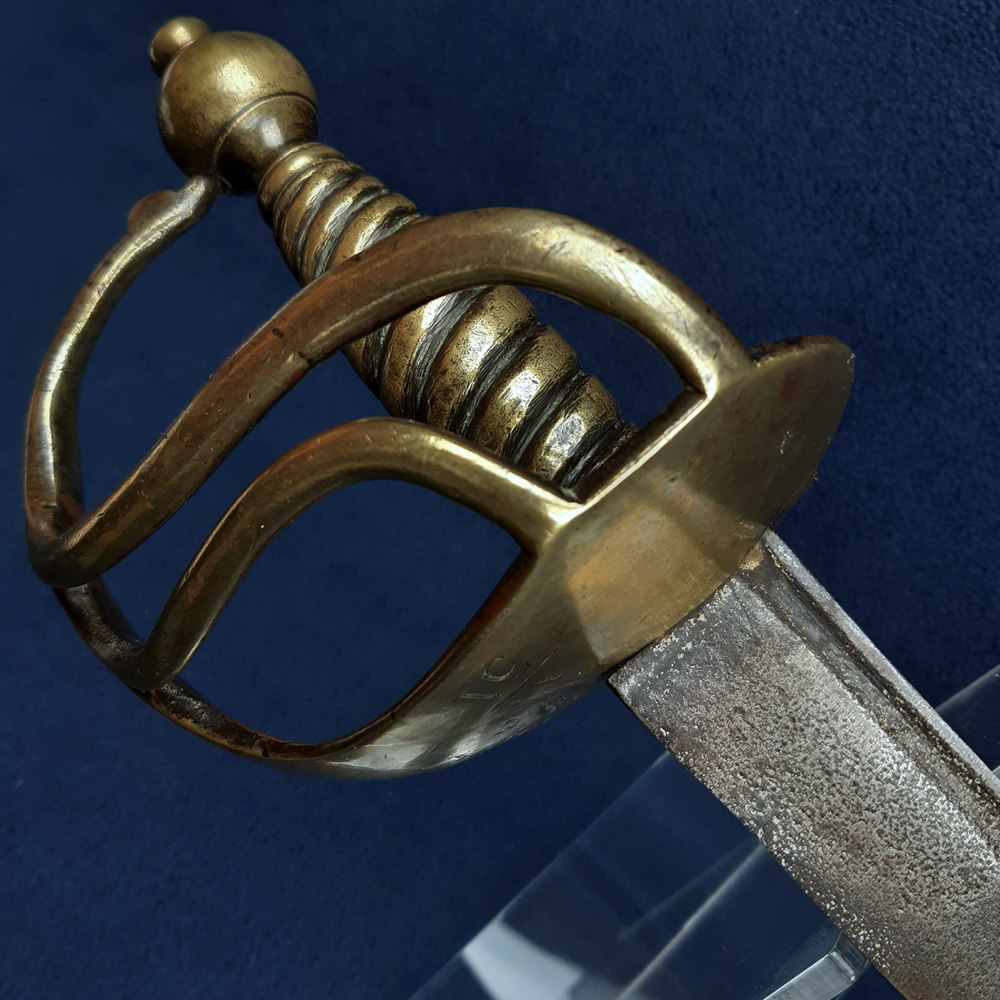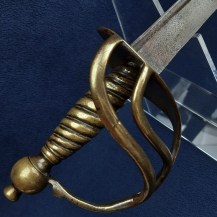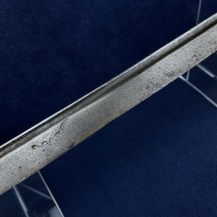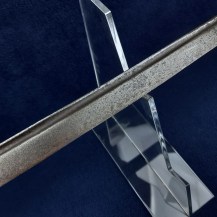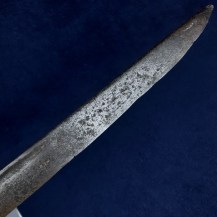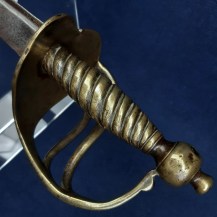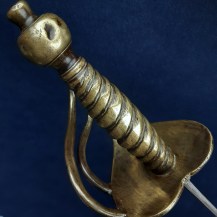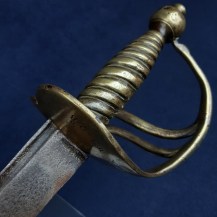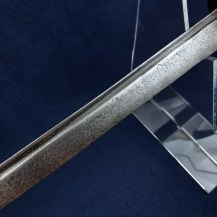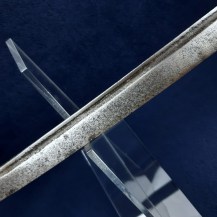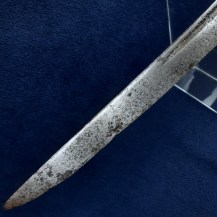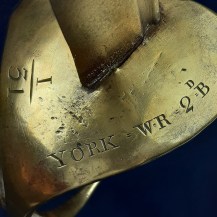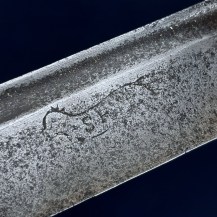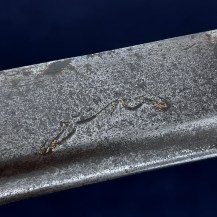English 1751 Pattern Infantry Hanger, 2nd West Riding of Yorkshire Militia, by Samuel Harvey
Slightly curved hanger blade with hatchet point, single narrow fuller close to the spine. Cast brass heart-shaped hilt with two side bars, spiral grip and round pommel. No scabbard. Blade length ~24¾ inches (62.9cm), the sword ~30¼ inches (76.9cm) overall.
The outside of the hilt is engraved with ‘YORK – W-R – 2 – DB’, indicating issue to the 2nd West Riding Militia a.k.a. 2nd Regiment of West Yorkshire Militia and ‘1 / 31’, most likely a rack number. The blade is stamped on both sides with a running fox within which are the initials ‘SH’, indicating the maker Samuel Harvey. It is also stamped at the shoulder on one side with a crown mark. This indicates government inspection or ownership and suggests this hanger was part of an officially ordered production run.
The ‘1751 Pattern’ is not an official pattern of British sword (built to specifications set by the military establishment) but a widely used type that appeared around that date, was purchased officially to some degree and issued to many regiments. In this era colonels of regiments typically controlled procurement of equipment but market availability affected their choices and some larger-scale ordering took place. The 1751 is simple and durable, its blade typical of the British ‘hanger’, and survives in some numbers today considering its age. Almost all examples are marked to a militia unit.
The West Riding of Yorkshire Militia was first raised in 1759, one of many created by the Militia Act of 1757 to respond to the threat posed by France during the Seven Years War. Parish constables drew up lists of all men aged 18 – 50, with limited exemptions, then drew ballots to select some for three years of compulsory militia service, although men chosen could delegate their role to paid substitutes if they could find & afford them.
Militia units were for home defence only, and could not be sent overseas – service in practice meant a few weeks of training each year and occasional mustering for duty in keeping public order, almost always outside their home county. Nonetheless, the compulsory system was unpopular and riots broke out in Lincolnshire in 1757 over the Bill’s passage, some wrongly believing that it meant they would be conscripted into fighting overseas. Several counties delayed implementing the changes for years for fear of similar civil unrest.
There were initially three regiments in the West Riding, but these were reorganized into two full regiments in 1763, the 1st and 2nd. The 2nd regiment, also called the Northern or ‘York Regiment’, was based at York and commanded by Col. William Thornton, who in 1745 had raised the ‘Yorkshire Blues’ militia at his own expense to oppose the Jacobite Rebellion, and fought with them at the battle of Falkirk. Along with their muskets and bayonets the rank and file were armed with ‘Small Hangers, with Brass Hilts, Scabbards, and tanned Leather Waist-Belts’.
The 2nd West Riding only assembled for their annual training until 1778 when it was embodied until the end of the American Revolutionary War in 1783. This pattern of brief periods of embodiment continued with no significant action.
In 1853 it became the 21st, or 2nd West York Light Infantry. In 1881 the Childers Reforms amalgamated militia and volunteer units with the regulars into larger regiments, attaching the county militia units to their respective county’s regiments as their third or fourth battalions. The regiment therefore became the 3rd Battalion, The Prince of Wales's Own (West Yorkshire Regiment). It was primarily a training unit during WW1 supplying trained men to the regular battalions, but being based at Whitley Bay was also part of the garrison on the Tyne.
The 3rd Battalion was disbanded in 1953. The lineage of the West Yorkshire Regiment is today maintained by the 2nd Battalion, Royal Yorkshire Regiment.
The firm of Samuel Harvey was established in 1748, and used the mark of the ‘running fox’ on both sides of their sword blades. After Samuel’s death in 1778 the family business was continued by his son and grandson, both of the same name, the last of whom died in 1810.
Like other swords of this period the hanger has a low carbon tang and shoulder, forge welded to a higher carbon steel blade, and the differential aging of the two materials can be seen clearly at the transition point. The two pieces were stepped to increase the surface area of the weld: one can see the line of the weld on the spine and the iron surface extends further up the blade on the right face than the left (roughly 2 1/8 inches vs 1 inch).
The blade has been sharpened, with a number of nicks to its edge, some shallow notches near the tip. The tip itself is rounded and fractionally bent to the right in its last 3mm. It has patches of patination overall, some light pitting to the iron at the forte of the blade spotted heavier pitting near the tip. The brass parts have moderate patination and a few dents, including a larger one to the pommel. No cracks to the hilt bars. The short quillon usually found on this type has been lost. Slight movement of the hilt side to side, while the grip itself remains firm.

